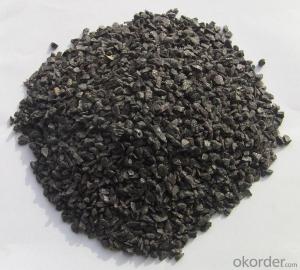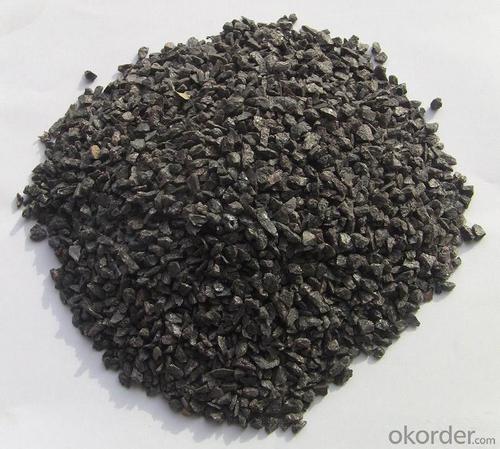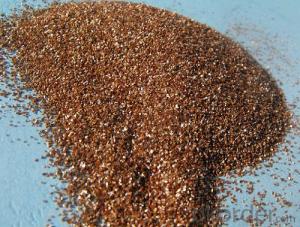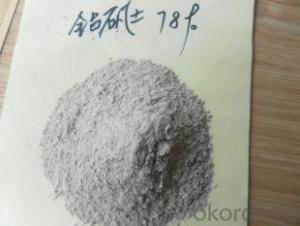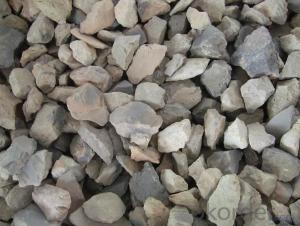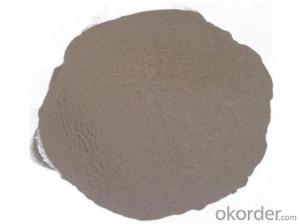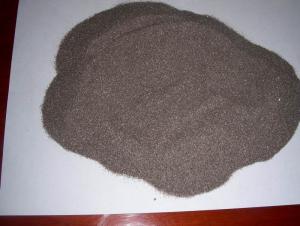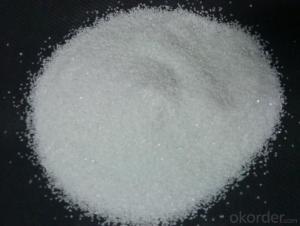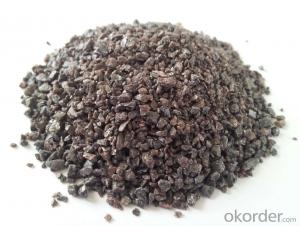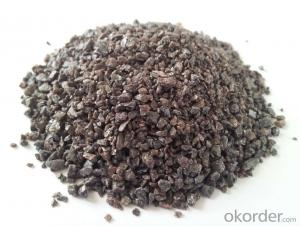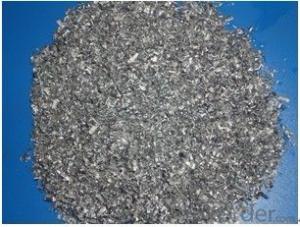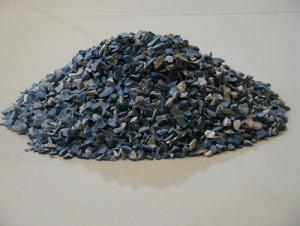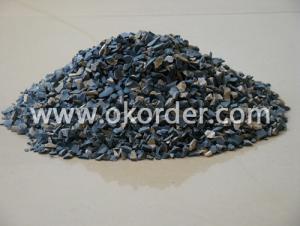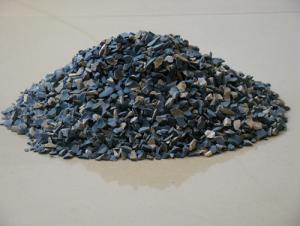Raw Materials for Refractory - Brown Fused Alumina Materials
- Loading Port:
- Tianjin
- Payment Terms:
- TT OR LC
- Min Order Qty:
- 20 m.t.
- Supply Capability:
- 1000 m.t./month
OKorder Service Pledge
OKorder Financial Service
You Might Also Like
Brown fused alumina is made from high quality bauxite by fusing in an electric arc furnace at high temperature. It has good toughness and high hardness. It can be used to make superior refractory products.
Specification
Application
Brown fused alumina is used as a raw material in the manufacture of high alumina refractories.
In the same condition, using manganese or silicon to deoxidize separately, the burn out rate are 46% and 37%, but it is only 29% if using manganese alloy to deoxidize. So, it is used widely to smelting steel and its output increases faster than ferroalloy's, so has become an indispensable composite deoxidizing and alloy additives in steel industry. The silicon-manganese which contains carbon below 1.9% still is used to produce medium/low-carbon ferromanganese and semi-finished products of electro silicothermic process manganese metal.
- Q: Physical and chemical indicators of various refractory.
- please read"Refractories Standard Series" for refernece, general business standards are higher than the national standard.
- Q: What are the requirements of refractory temperature of refractory brick?
- Oxygen fluctuation of load once happened during operation. Sometimes oxygen control valve will cause oxygen fluctuation of load, and sometimes large particles will block valve of high pressure coal slurry pump. The sudden drop in flow of coal slurry may cause relative excess of oxygen. Oxygen fluctuations directly cause fluctuations in furnace temperature. The range of oxygen fluctuations is 500m?-600m?. The maximum can reach about 1000m?. A sudden increase in oxygen causes a sudden increase in furnace temperature, which will suddenly burn out high-temperature thermocouple. The situation has a great influence on refractory brick and should be avoided. Furnace temperature is very inportant to life of lining of refractory bricks, so it should be strictly controlled not to overheat. There is a cinder layer on the surface of refractory bricks under the condition of normal production. In fact, cinder layer is dynamic. If the temperature is low, cinder layer is thick. If the temperature is high, cinder layer is thin. Appropriate cinder layer may slow the scour of high temperature gas and molten slag. The requirement of refractory brick is higher than that of stoves which use heavy oil as raw material. The main reason is permeability and corrosion of molten slag to refractory material. When replacing refractory bricks, it is found that penetration thickness is 10mm-20mm. After slag penetrates, strength decreases significantly. If temperature is high, erosion intensifies. According to the relevant information, when the operating temperature exceeds 1400 ℃, etching effect multiplies.
- Q: Is there any difference between insulating bricks and refractory bricks? Are there any professional refractories factories that are reliable in the quality and quality of these irritated materials?
- Seven characteristics of insulating brick:Insulation and heat insulation: effectively reduce energy consumption.Fire prevention: up to national standard or class A.Clean and environmental protection: no two pollution will be caused by air.Per square metre weighs only about 1.4 kilograms, reduce the burden of building.Simple production: completely break through the traditional process, greatly shorten the construction cycle.Beautiful: can be modulated into a variety of colors, suitable for Ming outfit.Durable: long service life.
- Q: How to use fireclay?
- Fire-resistant adhesive material is needed, its effect equals to the cement. Cement will certainly do.
- Q: What's the difference between refractory metal raceway and fireproof raceway?
- Refractory metal is used to lay and control cables, while trunking is used to lay wires and communication cables; refractory metal is bigger (200*100-600*200), while trunking is smaller; refractory metal has bigger turning radius, while trunking mostly turns a right angle; refractory metal has larger span, while trunking has smaller span; their fixation and installation ways are also different.
- Q: who knows the requirements of refractory for forge furnace?
- Here is the requirements of refractory for forge furnace: according to the chemical properties,casting fireproof materials are divided into three major categories: acidic, neutral and alkaline refractory materials. alkaline and neutral refractory materials are commonly used, such as alkaline magnesia-carbon bricks and burned magnesite bricks, magnesite-chrome bricks, magnesium-calcium brick, neutral high alumina brick, corundum brick, clay brick, etc., shapelessness materials include: castable refractory, ramming?mass, gunning mix, coating, dry vibrating materials and so on! Hope my answer can help you.
- Q: What are the requirements of the performances of brasque refractory?
- The requirements of the performances of brasque refractory: 1, should have sufficient refractoriness and softening point under a fixed load. Because under the action of the electric arc, the inner and surface temperature of the different parts of the brasque can be up to 1500 ~ 1800 ℃. 2, should have strong slag resistance. Because the inward permeation of slag and smoke at high temperature through its pores of brasque cause melting loss of refractories, organization delamination and flaking. 3, should have good thermal shock resistance. Because in the steelmaking process, opening the furnace door, lifting the furnace lid will cause sudden temperature change of brasque refractory,flaking and cracking, resulting in premature failure of brasque. 4, should have sufficient strength, because the brasque will be impacted at the time of loading, vibrated when tilting, flushed by metal, slag and gas flow when boiling. 5, the thermal conductivity and the conductivity should be small. Refractories commonly used for electric furnace include magnesia bricks, dolomite brick, high-alumina refractory bricks, silicious refractory brick and magnesite ramming material. Due to the different working environment of each parts of the furnace, refractories are different.
- Q: The following statement is correct: artificial corundum has a high melting point and can be used as a high grade refractory material. The main component is silica dioxide
- It's D,1. artificial corundum is mainly composed of three aluminium oxide two4, color glasses are not added cuprous oxide, silver halide is added
- Q: What are first rate fire resistant window materials?
- Natural environmental protection, non-poisoned, non-peculiar smell, non-radioactive; non-combustible, fireproofing, moisture-proof, corrosion-resistant; easy construction, lightweight, high strength, www. jsxsmy.
- Q: What are the differences between thermal?insulation?material and refractory?
- Just as its name implies, Thermal insulation means that it doesn't conduct heat instead it insulates heat inside, while refractory means resistance to high temperature and it will not be out of shape or damaged due to high temperature.
Send your message to us
Raw Materials for Refractory - Brown Fused Alumina Materials
- Loading Port:
- Tianjin
- Payment Terms:
- TT OR LC
- Min Order Qty:
- 20 m.t.
- Supply Capability:
- 1000 m.t./month
OKorder Service Pledge
OKorder Financial Service
Similar products
Hot products
Hot Searches
Related keywords
